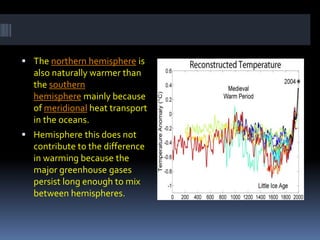Theglobalwarming
- 1. BUZDUGAN IONELA MIHAELA GROUP: 8218
- 2. Global warming and climate change are terms for the observed century-scale rise in the average temperature of the Earth's climate system and its related effects. Multiple lines of scientific evidence show that the climate system is warming. Temperature changes vary over the globe. Since 1979, land temperatures have increased about twice as fast as ocean temperatures. Ocean temperatures increase more slowly than land temperatures because of the larger effective heat capacity of the oceans and because the ocean loses more heat by evaporation.
- 3. The northern hemisphere is also naturally warmer than the southern hemisphere mainly because of meridional heat transport in the oceans. Hemisphere this does not contribute to the difference in warming because the major greenhouse gases persist long enough to mix between hemispheres.
- 4. Initial causes of temperature changes The climate system can respond to changes in external forcings. External forcings can "push" the climate in the direction of warming or cooling. Examples of external forcings include changes in atmospheric composition (e.g., increased concentrations of greenhouse gases, solar luminosity, volcanic eruptions).
- 5. Anthropogenic forcing has likely contributed to some of the observed changes, including sea level rise, changes in climate extremes as the number of warm and cold days, declines in Arctic see ice extent, glacier retreat and greening in Sahara. Detection “is the process of demonstrating that climate has changed in some defined statistical sense, without providing a reason for that change”. Detection does not imply attribution of the detected change to a particular cause.
- 6. Extreme weather Changes in regional climate are expected to include greater warming over land, with most warming at high northern latitudes, and least warming over the Southern Ocean and parts of the North Atlantic Ocean. Future changes in precipitation are expected to follow existing trends, with reduced precipitation over subtropical land areas, and increased precipitation at subpolar latitudes and some equatorial regions.
- 7. Long-term effects • On the timescale of centuries to millennia, the magnitude of global warming will be determined primarily by anthropogenic CO2 emissions. This is due to carbon dioxide's very long lifetime in the atmosphere. • Stabilizing global average temperature would require reductions in anthropogenic CO2 emissions. Reductions in emissions of non-CO2 anthropogenic greenhouse gases (e.g., methane and nitrous oxide) would also be necessary.







